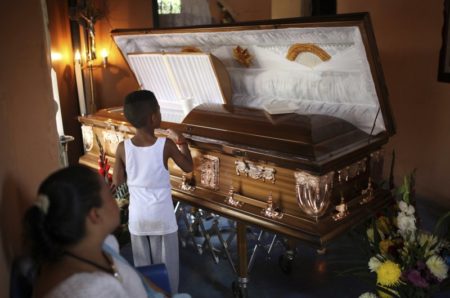This analysis by the Associated Press explores failures of the program to prevent murders of threatened journalists who enroll in it…
MEXICO CITY — After years of threats and attacks that Candido Rios blamed on a local mayor furious over his reporting, Rios’ home in Mexico’s deadliest state for journalists was encircled by a fence topped with coils of barbed wire and surrounded by a half-dozen surveillance cameras he monitored on screens in the living room.
None of that mattered the afternoon that he stopped, just like every other day on his way home from work, at a highway gas station store that is also a community meeting place of sorts. As Rios was chatting with a local rancher, armed men abruptly pulled up and opened fire, killing them and a former police inspector who had just come over.

In this Aug. 23, 2017 file photo, a boy looks into the coffin holding the body of Candido Rios Vazquez, a journalist who was murdered in Covarrubias,in Veracruz state. (PHOTO: Associated Press)
Rios, a hard-nosed crime reporter for Diario de Acayucan, had been in Mexico’s federal protection program for journalists since 2013, its first full year. On Aug. 22 at the gas station in the Veracruz state town of Covarrubias, he became the first reporter enrolled to be slain, sending a chilling message to anyone else relying on the program to stay safe.
Journalists and activists say the killing made it abundantly clear that the Mexico City-based program known as “the Mechanism” is incapable of protecting the nearly 600 enrollees working nationwide. The program has a staff of only about 30 and it has no security forces of its own.
Protective measures boil down to such things as home security and panic buttons on cellphones, and reporters say that still leaves them dangerously exposed if they continue to work. They say seeking safety in exile or by hunkering down in safe spaces is no way to practice journalism.
“The measures they provided were effective for a time, but inside the home,” said Cristina Rios Nieves, the slain journalist’s daughter. “My father didn’t work from home. His profession was to be outside the home working, walking, looking for stories.”
Plagued by drug gangs and corrupt officials who are often in cahoots with cartels, Mexico has become one of the world’s deadliest countries for journalists of nations not in open war. Nine reporters have been slain so far this year, and the free-speech activist group Articulo 19 counts more than 100 since 2000 in what observers call a full-blown crisis for freedom of expression.
The Mechanism for the Protection of Human Rights Defenders and Journalists was set up to try to stem the bloodshed. It evaluates threats to journalists and offers them help in the form of things like panic buttons, home fortification and, in rare cases, bodyguards. As a last resort, it will help them and their families relocate.
Rios, who covered crime just like most Mexican journalists who end up dead, had been under the Mechanism’s protection longer than just about anyone. Based in a rural area of eastern Veracruz that is dominated by ranching and sugar cane farming, he ran afoul of a local mayor starting in 2001 for his reporting about the disappearance of a town councilman and the reporter’s conclusion that the mayor was responsible.
That began what Rios described as years of harassment, beatings and detentions that he alleged were orchestrated by the former mayor of Hueyapan, Gaspar Gomez. Rios suffered broken ribs in one attack and walked with a cane.
To read complete article click here.
Source: apnews.com



